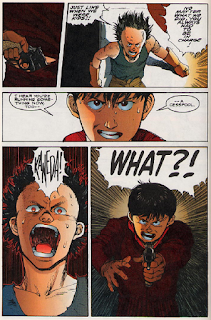Akira is a manga created by Katsuhiro
Otomo. The six-volume series is set is a post-apocalyptic Neo-Tokyo in the year
2019, built amidst the ashes of an unknown explosion that happened in 1982.
Clues about the past catastrophe tend to resurface, and a youth gang lead by
Kaneda managed to uncover government secrets.
The manga explores human desires on
power and corruption. Although Akira is a science fiction, the manga triumphs
in the incorporation of realism in each of its pages. From depictions of
three-dimensional characters to vivid painting of a dystopian future, Akira
rose above of its kind due to breakage of common manga conventions.
Intricate Characters
A major problem in most of manga is
the proliferation of one-dimensional characters. This is a trope wherein the
only thing that describes a character is his/her motivations. All characters
are designed to have motivations that force them to do some actions, which in
turn drive the story forward. In reality, human beings tend to shape and be
shaped of certain events. A one-dimensional character is a product of a writer
who focused solely on the plot without giving one’s characters room to evolve. Otomo
managed to give every character enough background for the readers to know them
more. He managed to depict Tetsuo’s frustration as a weakling in the face of
Kaneda. Kei, a character who was always overshadowed by her own gender, struggles
to have importance in a testosterone-fueled society. The Colonel, the head of
Neo-Tokyo’s Akira project, is powerless to protect Neo-Tokyo from chaos. These
different aspects of human experiences are present in Akira which makes the
characters more relatable to the readers.
Not in-your-face
Another common problem in a lot of
manga series is the writer’s need to spoon-feed everything that is happening in
the story. One manifestation of this is the frequent use of thinking bubble to
portray what a character is thinking even though it is obvious to the reader what
they feel. Current American comics doesn’t use this technique anymore and
everything is portrayed using dialogue bubbles or narrations. It is very brave
of Otomo to include such subtleties to be present in Akira, even though concepts
like creation of a universe in one’s mind are complicated to discuss. It is up
to readers to know and find out what is happening in the story on their own.
This not-in-your-face method of telling a story in the graphic medium induces a
two-way active connection with the reader. It requires more from the reader and
the reward of finding out the truth in the story is more satisfying.
System on a Background
of Chaos
Akira is a very chaotic manga.
There are lots of action, graphic violence, and explosions. Even though this is
the case, the chaos is laid down in every page in a systematic way that the
reader still understands what is happening. One manifestation of the system is
the use of non-overlapping grids in every panel which does not confuse readers
on where panels start or end. The use of overlapping grids is prominent in a
lot of manga especially on scenes where lots of action if happening. This is a
bad practice since it multiplies confusion for the readers. Another
manifestation is prior to the confrontation: the motivations of every character
are known which makes readers understand layers of reasons and results of any
battles.



